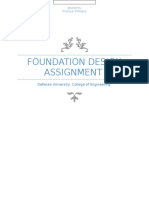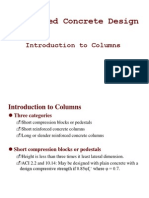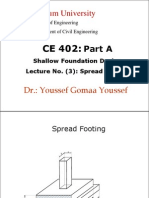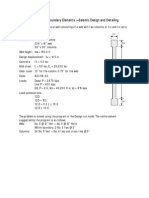Diseño de Columnas
Diseño de Columnas
Uploaded by
Sovich82Copyright:
Available Formats
Diseño de Columnas
Diseño de Columnas
Uploaded by
Sovich82Copyright
Available Formats
Share this document
Did you find this document useful?
Is this content inappropriate?
Copyright:
Available Formats
Diseño de Columnas
Diseño de Columnas
Uploaded by
Sovich82Copyright:
Available Formats
The following examples illustrate the design methods presented in the PCA book Simplified Design -
Reinforced Concrete Buildings of Moderate Size and Height third edition. Unless otherwise noted, all
referenced table, figure, and equation numbers are from that book. The examples presented here are
for columns.
Examples for walls are available on our Web page: www.cement.org/buildings.
Example 1
In this example, an interior column at the 1
st
floor level of a 7-story building is designed for the effects
of gravity loads. Structural walls resist lateral loads, and the frame is nonsway.
Materials
Concrete: normal weight (150 pcf),
3
/4-in. maximum aggregate, f
c
= 4,000 psi
Mild reinforcing steel: Grade 60 (f
y
= 60,000 psi)
Loads
Floor framing dead load = 90 psf
Superimposed dead loads = 30 psf
Live load = 100 psf (floor), 20 psf (roof)
Building Data
Typical interior bay = 30 ft x 30 ft
Story height = 12 ft-0 in.
The table below contains a summary of the axial loads due to gravity. The total factored load P
u
is com-
puted in accordance with Sect. 9.2.1, and includes an estimate for the weight of the column. Live load
reduction is determined from ASCE 7-02. Moments due to gravity loads are negligible.
Floor DL (psf) LL (psf) Red. LL (psf) P
u
(kips) Cum. P
u
(kips)
7 80 20 20.0 125 125
6 120 100 50.0 212 337
5 120 100 42.7 201 538
4 120 100 40.0 197 735
3 120 100 40.0 197 932
2 120 100 40.0 197 1,129
1 120 100 40.0 197 1,326
Use Fig. 5-1 to determine a preliminary size for the tied column at the 1
st
floor level.
Assuming a reinforcement ratio
g
= 0.020, for P
u
= 1,326 kips, a 24 x 24 column is required.
Check if slenderness effects need to be considered.
TIME SAVING DESIGN AIDS
Columns
Page 1 of 9
Since the column is part of a nonsway frame, slenderness effects can be neglected when the unsupported
column length is less than or equal to 12h, where h is the column dimension (ACI 318-05 Sect. 10.12.2).
12h = 12 x 24 = 288 in. = 24 ft > 12 ft story height, which is greater than the unsupported length of the
column. Therefore, slenderness effects can be neglected.
To determine the required area of longitudinal reinforcement.
For a 24 x 24 in. column at the 1
st
floor level:
A
s
= 0.02 x 24 x 24 = 11.52 in.
2
Try 8-No. 11 bars (A
s
= 12.48 in.
2
)
Check Eq. (10-2) of ACI 318-05:
P
n(max)
= 0.80[0.85f
c
(A
g
A
st
) + f
y
A
st
]
= 1,386 kips > 1,326 kips O.K.
3-No. 11 bars can be accommodated on the face of a 24-in. wide column with normal lap splices and
No. 4 ties.
Determine required ties and spacing.
According to Sect. 7.10.5.1, No. 4 ties are required when No. 11 longitudinal bars are used.
According to Sect. 7.10.5.2, spacing of ties shall not exceed the least of:
16 long. bar diameters = 16 x 1.41
= 22.6 in. (governs)
48 tie bar diameters = 48 x 0.5
= 24 in.
Least column dimension = 24 in.
Check clear spacing of longitudinal bars:
Clear space = - 1.41 = 7.9 in.
Since the clear space between longitudinal bars > 6 in., cross-ties are required per ACI 318-05 Sect.
7.10.5.3.
Reinforcement details are shown below.
See ACI 318-05 Sect. 7.8 for additional special reinforcement details for columns.
24 2 1 5 0 5
1 4
2
2
- . + . +
. 1
TIME SAVING DESIGN AIDS
Columns
Page 2 of 9
Example 2
In this example, a simplified interaction diagram is constructed for an 18 in. x 18 in. tied column rein-
forced with 8-No. 9 Grade 60 bars (
g
= 8/18
2
= 0.0247). Concrete compressive strength = 4 ksi.
Use the simplified equations to determine the 5 points on the interaction diagram.
Point 1: Pure compression
P
n(max)
= 0.80A
g
[0.85f
c
+
g
(f
y
- 0.85f
c
)]
= 0.52 x 182[(0.85 x 4) + 0.0247 (60 - (0.85 x 4))]
= 809 kips
Point 2 (f
st
= 0)
Layer 1:
1 - C
2
= 1 - 1(1) = 0
Layer 2:
1 - C
2
= 1 - 1 = 0.42
Layer 3:
1 - C
2
= 1 - 1 = 0.84
Since 1 C
2
(d
3
/d
1
) > 0.69, the steel in layer 3 has yielded.
9 00
15 56
.
.
d
d
3
1
9 00
15 56
.
.
d
d
2
1
d
d
1
1
TIME SAVING DESIGN AIDS
Columns
Page 3 of 9
8-No. 11
No. 4 ties @ 22
24
24
Therefore, set 1 C
2
(d
3
/d
1
) = 0.69 to ensure that the stress in the bars in layer 3 is equal to 60 ksi.
P
n
=
= 0.65{(2.89 x 15.56 x 18)
+ 87[(3 x 0) + (2 x 0.42)
+ (3 x 0.69)]}
= 0.65 (809.4 + 253.2)
= 691 kips
M
n
= /12
= 0.65{(0.5 x 2.89 x 15.56 x 18)
x (18-0.85 x 15.56)
+ 87[(3 x 0) (9 - 15.56)
+ (2 x 0.42) (9 - 9)
+ (3 x 0.69) (9 - 2.44)]} /12
= 0.65 (1,932.1 + 1,181.4) /12
= 169 ft - kips
0 5C db h C d 87 A 1 C
d
d
h
2
d
1 1 3 1 si 2
i
1
i
i 1
n
.
( )
+
C db 87 A 1 C
d
d
1 1 si
i 1
n
2
i
1
+
TIME SAVING DESIGN AIDS
Columns
Page 4 of 9
d
3
=
2
.
4
4
18
1
.
5
(
t
y
p
.
)
d
2
=
9
.
0
0
d
1
=
1
5
.
5
6
1
8
No. 3 tie
3-No. 9
2-No. 9
3-No. 9
Point 3 (f
st
= -0.5f
y
)
Layer 1:
1 - C
2
= 1 - 1.35 (1) = -0.35
Layer 2:
1 - C
2
= 1 - 1.35 = 0.22
Layer 3:
1 - C
2
= 1 - 1.35 = -0.79, Use 0.69
P
n
=
= 0.65{(2.14 x 15.56 x 18)
+ 87[(3 x -0.35) + (2 x 0.22)
+ (3 x 0.69)]}
= 0.65 (599.4 + 127.0)
= 472 ft - kips
M
n
= /12
= 0.65{(0.5 x 2.14 x 15.56 x 18)
(18 - 0.63 x 15.56)
+ 87[(3 x -0.35) (9 - 15.56)
+ (2 x 0.23) (9 - 9)
+ (3 x 0.69) (9 - 2.44)]} /12
= 0.65 (2,456.6 + 1,780.7) /12
= 230 ft - kips
0 5C db h C d 87 A 1 C
di
d
h
2
d
1 1 3 1 si 2
1
i
i 1
n
.
( )
+
C db 87 A 1 C
di
d
1 1 si 2
1 i 1
n
+
2 44
15 56
.
.
d
d
3
1
9 00
15 56
.
.
d
d
2
1
d
d
1
1
TIME SAVING DESIGN AIDS
Columns
Page 5 of 9
Point 4 (f
st
= -f
y
)
Layer 1:
1 - C
2
= 1 - 1.69 (1) = -0.69
Layer 2:
1 - C
2
= 1 - 1.69 = 0.02
Layer 3:
1 - C
2
= 1 - 1.69 = 0.74, Use 0.69
P
n
=
= 0.65{(1.70 x 15.56 x 18)
+ 87[(3 x -0.69) + (2 x 0.02)
+ (3 x 0.69)]}
= 0.65 (476.1 + 3.5)
= 312 kips
M
n
= /12
= 0.65{[(0.5 x 1.70 x 15.56 x 18)
x (18 - 0.50 x 15.56)
+ 87[(3 x -0.69) (9 - 15.56)
+ (2 x 0.02) (9 - 9)
+ (3 x 0.69) (9 - 2.44)]} /12
= 0.65 (2,433.1 + 2,362.8) /12
= 260 ft - kips
0 5C db h C d 87 A 1 C
d
d
h
2
d
1 1 3 1 si 2
i
1
i
i 1
n
.
( )
+
C db 87 A 1 C
d
d
1 1 si 2
i
1 i 1
n
+
2 44
15 56
.
.
d
d
3
1
9 00
15 56
.
.
d
d
2
1
d
d
1
1
TIME SAVING DESIGN AIDS
Columns
Page 6 of 9
Point 5: Pure bending
Use iterative procedure to determine M
n
.
Try c = 4.0 in.
s1
= 0.003
= 0.003
= -0.0087
f
s1
= E
s
s1
= 29,000 x (-0.0087) = -251.4 ksi > -60 ksi, use f
s1
= -60 ksi
T
s1
= A
s1
f
s1
= 3 x (-60) = -180 kips
s2
= 0.003
= 0.003
= -0.0038
f
s2
= E
s
s2
= 29,000 x (-0.0038) = -108.8 ksi > -60 ksi, use f
s2
= -60 ksi
T
s2
= A
s2
f
s2
= 2 x (-60) = -120 kips
s3
= 0.003
= 0.003
= 0.0012
f
s3
= E
s
s2
= 29,000 x (0.0012) = 33.9 ksi
C
s3
= A
s3
f
s3
= 3 x 33.9 = 102 kips
C
c
= 0.85f
c
ab
= 0.85 x 4 x (0.85 x 4) x 18
= 208 kips
4 2 44
4
.
c d
c
3
4 9
4
c d
c
2
4 15 56
4
.
c d
c
1
TIME SAVING DESIGN AIDS
Columns
Page 7 of 9
Total T = (-180) + (-120) = -300 kips
Total C = 102 + 208 = 310 kips
Since T C, use c = 4.0 in.
M
ns1
= T
s1
/12
= 98.4 ft - kips
M
ns2
= T
s2
/12
= 0
M
ns3
= C
s3
/12
= 55.8 ft - kips
M
n
= 0.5C
c
/12 + 154.2
= 280.7 ft - kips
M
n
= 0.9 x 280.7 = 253 ft - kips
Compare simplified interaction diagram to interaction diagram generated from the PCA computer program
pcaColumn.
The comparison is shown on the next page. As can be seen from the figure, the comparison between the
exact (black line) and simplified (red line) interaction diagrams is very good.
h a M 0 5 208 18 3 4
nsi
i 1
3
( )
( ) [ ]
+ =
=
. .
h
2
d 102
18
2
2 44
3
= .
h
2
d 120
18
2
9
2
( )
= -
h
2
d 180
18
2
15 56
i
( )
= - .
TIME SAVING DESIGN AIDS
Columns
Page 8 of 9
TIME SAVING DESIGN AIDS
Columns
Page 9 of 9
You might also like
- RIICWD601E Student Assessment Tasks AnswersDocument25 pagesRIICWD601E Student Assessment Tasks AnswersNavneet Mehra0% (2)
- Andrew J. Charlett, Maybery-Thomas Craig-Fundamental Building Technology-Spon Press (2007) PDFDocument259 pagesAndrew J. Charlett, Maybery-Thomas Craig-Fundamental Building Technology-Spon Press (2007) PDFSovich82100% (1)
- Recommended Practice Tremie Concrete AustraliaDocument43 pagesRecommended Practice Tremie Concrete AustraliaPablo Menendez100% (1)
- ATI TEAS Calculation Workbook: 300 Questions to Prepare for the TEAS (2024 Edition)From EverandATI TEAS Calculation Workbook: 300 Questions to Prepare for the TEAS (2024 Edition)No ratings yet
- Wide Beam DesignDocument6 pagesWide Beam DesignNaveen RevannaNo ratings yet
- Design Examples 1 2 of Circular Silo PDFDocument7 pagesDesign Examples 1 2 of Circular Silo PDFAnicet Vincent70% (10)
- Strut-And-Tie Model ExampleDocument18 pagesStrut-And-Tie Model ExamplemikeengineeringNo ratings yet
- Beam Design For Torsion ExampleDocument9 pagesBeam Design For Torsion ExampleKhajaNo ratings yet
- Astm d7272Document6 pagesAstm d7272Manuel ContrerasNo ratings yet
- MosDocument3 pagesMosrajapratyNo ratings yet
- Culvert Design - WEEK 4 LECTURE NOTESDocument31 pagesCulvert Design - WEEK 4 LECTURE NOTESDammy Taiwo-AbdulNo ratings yet
- Time Saving Column Design by Is CodeDocument10 pagesTime Saving Column Design by Is CodeNaveen RevannaNo ratings yet
- Time Saving DesignDocument22 pagesTime Saving DesignViswanadh OngoluNo ratings yet
- Design Example Columns ACI 318 05Document7 pagesDesign Example Columns ACI 318 05Murali Krishna Reddy ArikatlaNo ratings yet
- Steel Column BeamDocument6 pagesSteel Column Beamdharul khairNo ratings yet
- Indrumator Metal - EGDocument37 pagesIndrumator Metal - EGhooky1100% (1)
- CE413 - Steel LacingDocument38 pagesCE413 - Steel LacingSaba MohsinNo ratings yet
- Example 3 Rectangular SiloDocument7 pagesExample 3 Rectangular SiloAhmed Said50% (2)
- Foundation Design Assignment: Defense University Collage of EngineeringDocument20 pagesFoundation Design Assignment: Defense University Collage of EngineeringAmanuel Q. MulugetaNo ratings yet
- Design of Sections Subjected To Eccentric ForcesDocument26 pagesDesign of Sections Subjected To Eccentric ForcesAbdo YahiaNo ratings yet
- Punching of Flat Slabs: Design Example: Fib Model Code 2010Document13 pagesPunching of Flat Slabs: Design Example: Fib Model Code 2010Bhagirath JoshiNo ratings yet
- Faculty of Applied Engineering and Urban PlanningDocument22 pagesFaculty of Applied Engineering and Urban PlanningHazem Almasry100% (1)
- Practical Design To Eurocode 2: Strain CompatibilityDocument30 pagesPractical Design To Eurocode 2: Strain CompatibilityschneekhanNo ratings yet
- Recitation 5ADocument14 pagesRecitation 5AShaminda AmbaheraNo ratings yet
- Short ColumnDocument15 pagesShort ColumnNico GeotinaNo ratings yet
- Mechanics of Materials Solutions For Some ProbsDocument5 pagesMechanics of Materials Solutions For Some ProbsChirag AnandNo ratings yet
- TIME SAVING DESIGN AIDS - Concrete WallsDocument6 pagesTIME SAVING DESIGN AIDS - Concrete WallsalshaijiNo ratings yet
- Software Verification: ACI 318-11 Example 002Document4 pagesSoftware Verification: ACI 318-11 Example 002Emad KhanNo ratings yet
- Example Design of Circular Beam ACI 1999Document5 pagesExample Design of Circular Beam ACI 1999José Pablo Rosales Sánchez100% (3)
- 3 Spread FootingDocument17 pages3 Spread Footingkhajaimad100% (2)
- ASDIP Foundation - Combined Footing Verification Example PDFDocument5 pagesASDIP Foundation - Combined Footing Verification Example PDFwaseq911No ratings yet
- Concrete Design14 Analysis Design Torsion 2Document7 pagesConcrete Design14 Analysis Design Torsion 2cocococo1100% (1)
- JB 2017 Question Solution by DESIGN INTEGRITYDocument6 pagesJB 2017 Question Solution by DESIGN INTEGRITYBetty L SnowNo ratings yet
- Selection of Concrete-FilledDocument2 pagesSelection of Concrete-Filledivan bolañosNo ratings yet
- Chapt 10Document22 pagesChapt 10yaori700% (1)
- Semana 08 - Mathcad - N5-06 Diseno Viga Doblemente ArmadaDocument10 pagesSemana 08 - Mathcad - N5-06 Diseno Viga Doblemente ArmadaStefany SilveiraNo ratings yet
- Ec9 Ex43 Bending Trapez Class 2Document7 pagesEc9 Ex43 Bending Trapez Class 2imotalpNo ratings yet
- Workbook Workbook Workbook Workbook Workbook: Try Yourself QuestionsDocument26 pagesWorkbook Workbook Workbook Workbook Workbook: Try Yourself QuestionsShubham mishraNo ratings yet
- Aci 318-14 Wall-002 PDFDocument5 pagesAci 318-14 Wall-002 PDFVILCA100% (2)
- Practical Design To Eurocode 2: Outline - Week 4Document46 pagesPractical Design To Eurocode 2: Outline - Week 4maminu1No ratings yet
- ConnectionDocument6 pagesConnectionRidho Septian RahmanNo ratings yet
- L12 Bolt Connection 2Document17 pagesL12 Bolt Connection 2Kidus KidaneNo ratings yet
- SH Wall ExampleDocument7 pagesSH Wall Examplericopadilla79No ratings yet
- Base Plate PresentationDocument15 pagesBase Plate Presentationprabhu81No ratings yet
- T-Girder Bridge Design: Design Data and Specifications I) Material PropertiesDocument10 pagesT-Girder Bridge Design: Design Data and Specifications I) Material Propertieskhedira samiNo ratings yet
- Anchorage To ConcreteDocument10 pagesAnchorage To ConcretemakakkNo ratings yet
- 07-Design of Stringer BracingDocument17 pages07-Design of Stringer BracingTran Nhu Hoa100% (1)
- Analytical Modeling of Solute Transport in Groundwater: Using Models to Understand the Effect of Natural Processes on Contaminant Fate and TransportFrom EverandAnalytical Modeling of Solute Transport in Groundwater: Using Models to Understand the Effect of Natural Processes on Contaminant Fate and TransportNo ratings yet
- A Brief Introduction to MATLAB: Taken From the Book "MATLAB for Beginners: A Gentle Approach"From EverandA Brief Introduction to MATLAB: Taken From the Book "MATLAB for Beginners: A Gentle Approach"Rating: 2.5 out of 5 stars2.5/5 (2)
- Mathematical and Computational Modeling: With Applications in Natural and Social Sciences, Engineering, and the ArtsFrom EverandMathematical and Computational Modeling: With Applications in Natural and Social Sciences, Engineering, and the ArtsRoderick MelnikNo ratings yet
- Advanced AutoCAD® 2017: Exercise WorkbookFrom EverandAdvanced AutoCAD® 2017: Exercise WorkbookRating: 1 out of 5 stars1/5 (1)
- Trigonometric Ratios to Transformations (Trigonometry) Mathematics E-Book For Public ExamsFrom EverandTrigonometric Ratios to Transformations (Trigonometry) Mathematics E-Book For Public ExamsRating: 5 out of 5 stars5/5 (1)
- Advanced Opensees Algorithms, Volume 1: Probability Analysis Of High Pier Cable-Stayed Bridge Under Multiple-Support Excitations, And LiquefactionFrom EverandAdvanced Opensees Algorithms, Volume 1: Probability Analysis Of High Pier Cable-Stayed Bridge Under Multiple-Support Excitations, And LiquefactionNo ratings yet
- Laboratory Exercises in Astronomy: Solutions and AnswersFrom EverandLaboratory Exercises in Astronomy: Solutions and AnswersNo ratings yet
- Calculo Hidrologico RIO BUIN OKDocument23 pagesCalculo Hidrologico RIO BUIN OKSovich82No ratings yet
- Civil 3D Creating Custom PartsDocument34 pagesCivil 3D Creating Custom PartsSovich82No ratings yet
- Diseño de PlacasDocument11 pagesDiseño de PlacasSovich82No ratings yet
- Hybrid Masonry Design 2.13.01 - 12.29.09Document6 pagesHybrid Masonry Design 2.13.01 - 12.29.09Sovich82No ratings yet
- RCC31 One-Way Slabs (A&d)Document14 pagesRCC31 One-Way Slabs (A&d)Sovich82No ratings yet
- 09 - (4th Civil) (Tanks) Circular TanksDocument97 pages09 - (4th Civil) (Tanks) Circular TanksSovich82100% (1)
- RCC11 Element DesignDocument6 pagesRCC11 Element DesignSovich82No ratings yet
- Alternate Path Method in Progressive Collapse Analysis - Variation of Dynamic and Non-Linear Load Increase Factors PDFDocument84 pagesAlternate Path Method in Progressive Collapse Analysis - Variation of Dynamic and Non-Linear Load Increase Factors PDFSovich82No ratings yet
- Experinced CV OPERATION MANAGER (Business Development Manager)Document4 pagesExperinced CV OPERATION MANAGER (Business Development Manager)liezensubmissionNo ratings yet
- Slide Topic 1 ACMV System (Part 2)Document13 pagesSlide Topic 1 ACMV System (Part 2)Emi Ariyani ArisNo ratings yet
- 2014 NCEES 8hr Exam StandardsDocument6 pages2014 NCEES 8hr Exam StandardsTioAntonioNo ratings yet
- Cetorex GroutDocument2 pagesCetorex GroutMosaad KeshkNo ratings yet
- 37-2013-00078268-Cu-Bt-Ctl Roa-1 12-04-13 Complaint 1386637937306Document118 pages37-2013-00078268-Cu-Bt-Ctl Roa-1 12-04-13 Complaint 1386637937306api-218643948No ratings yet
- 2 - 254624-400-DS-INT-021 Plug Valve DSDocument10 pages2 - 254624-400-DS-INT-021 Plug Valve DSNerudaArar100% (1)
- Kit B CloroDocument2 pagesKit B CloroTomas Gaviria MartinezNo ratings yet
- Selection of The Type of Dam & Their ClassificationDocument16 pagesSelection of The Type of Dam & Their ClassificationTony StarkNo ratings yet
- Joh. Heinr. Bornemann GMBH Postfach 1162, D-31676 Obernkirchen Phone: +49 5724 390-0 Fax +49 5724 390 290Document6 pagesJoh. Heinr. Bornemann GMBH Postfach 1162, D-31676 Obernkirchen Phone: +49 5724 390-0 Fax +49 5724 390 290vuthanhNo ratings yet
- Sika Bitumen 60Document2 pagesSika Bitumen 60Ahmed AbdallahNo ratings yet
- Piping Class CS1 300 4Document3 pagesPiping Class CS1 300 4rakicbg100% (1)
- Close Coupled Pumps Operating and Maintenance ManualDocument16 pagesClose Coupled Pumps Operating and Maintenance ManualsaifNo ratings yet
- 6 MFL Tool Spec Rev 3.5Document1 page6 MFL Tool Spec Rev 3.5fadialkasrawiNo ratings yet
- Classification of Materials NotesDocument9 pagesClassification of Materials NotesJohn K KikwaiNo ratings yet
- 6TH Sem PapersDocument23 pages6TH Sem Papersrajkumarmeena9462No ratings yet
- Structural Construction Engg PDFDocument57 pagesStructural Construction Engg PDFSrikanth NuneNo ratings yet
- Pile CapDocument8 pagesPile CapMdShahbazAhmedNo ratings yet
- Oht 76Document19 pagesOht 76suraj sarkarNo ratings yet
- Procurement of Infrastructure Projects: Construction of Two (2) Storey Ten (10) Classrooms at Lanao Del Sur I DivisionDocument51 pagesProcurement of Infrastructure Projects: Construction of Two (2) Storey Ten (10) Classrooms at Lanao Del Sur I DivisionSalic bashierNo ratings yet
- 400 AnsysDocument13 pages400 AnsysCostas SachpazisNo ratings yet
- Brochure HDPEDocument4 pagesBrochure HDPEAhmad MuchroniNo ratings yet
- Curriculum For B.Tech (Evening) Degree Semesters I To VIII 2016Document8 pagesCurriculum For B.Tech (Evening) Degree Semesters I To VIII 2016shalu R FNo ratings yet
- 19H61A0152Document27 pages19H61A0152153-B RAKSHITHANo ratings yet
- Ra 11396Document9 pagesRa 11396Ivy Galit Dula100% (1)
- Air-Op Diaphragm Pmps PDFDocument2 pagesAir-Op Diaphragm Pmps PDFGigin PlusNo ratings yet


































































































